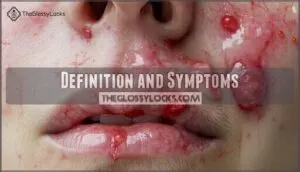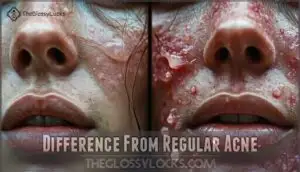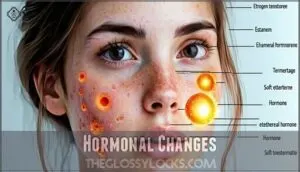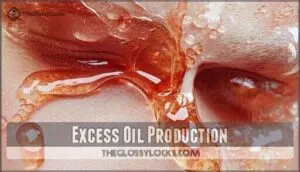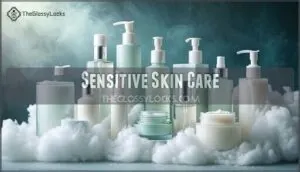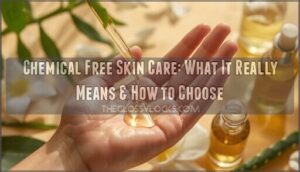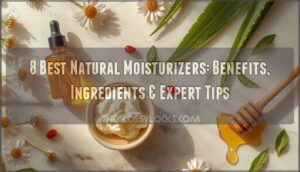This site is supported by our readers. We may earn a commission, at no cost to you, if you purchase through links.
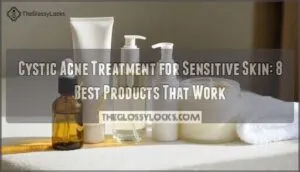
You’ll want to start with gentle retinoids like adapalene, which works slower than harsh alternatives but won’t leave your face resembling a tomato.
Benzoyl peroxide at 2.5% concentration fights bacteria without the nuclear-level irritation of stronger formulas.
Salicylic acid helps unclog pores while being kinder to reactive skin.
The secret sauce? Layer a fragrance-free moisturizer before and after treatment to create a protective barrier.
Your skin needs time to adjust, so patience beats aggressive scrubbing every time.
The right product combinations can transform your routine completely.
Table Of Contents
- Key Takeaways
- What is Cystic Acne
- Cystic Acne Causes
- 8 Best Cystic Acne Treatments
- 1. Differin Acne Treatment Gel Retinoid
- 2. CeraVe Acne Foaming Cream Cleanser
- 3. PanOxyl 4% Benzoyl Peroxide Acne Wash
- 4. Neutrogena Rapid Clear Acne Treatment
- 5. Paulas Choice BHA Liquid Exfoliant
- 6. La Roche Posay Face Moisturizer
- 7. Neutrogena Oil-Free Salicylic Acid Cleanser
- 8. La Roche-Posay Adapalene Acne Treatment
- Sensitive Skin Care
- Preventing Cystic Acne
- Frequently Asked Questions (FAQs)
- What is the fastest way to get rid of a cystic pimple?
- What do dermatologists recommend for acne on sensitive skin?
- Is cystic acne hormonal or bacterial?
- What not to put on cystic acne?
- How long does cystic acne take to heal?
- Can makeup worsen cystic acne on sensitive skin?
- When should I see a dermatologist for treatment?
- Are natural remedies safe for sensitive cystic acne?
- What skincare ingredients should sensitive skin avoid completely?
- Conclusion
Key Takeaways
- Start gentle and build slowly – You’ll want to begin with low-concentration treatments like 2.5% benzoyl peroxide or adapalene, then gradually increase the frequency as your skin adjusts to avoid irritation.
- Layer protection before and after treatment – Apply a fragrance-free moisturizer both before and after your acne treatments to create a protective barrier that prevents over-drying and irritation.
- Choose proven ingredients over harsh alternatives – Stick with gentle retinoids, salicylic acid, and low-concentration benzoyl peroxide rather than aggressive scrubs or high-strength formulas that will inflame sensitive skin.
- Consistency beats intensity every time – You’ll see better results with regular use of gentle products than with sporadic use of harsh treatments, so patience and routine maintenance are your keys to success.
What is Cystic Acne
You’ve probably noticed that cystic acne isn’t your typical pimple—it’s those painful, swollen bumps that form deep under your skin and feel like they’re never going away.
Those stubborn, throbbing bumps beneath your skin that refuse to surface—and seem determined to stick around forever.
Unlike regular acne that sits on the surface, these stubborn cysts develop when oil, bacteria, and dead skin cells get trapped in your pores, creating inflamed, pus-filled lumps.
These inflamed, pus-filled lumps can leave lasting scars if not treated properly, which is a key consideration in managing cystic acne to prevent long-term damage, and the condition is characterized by painful bumps.
Definition and Symptoms
Cystic acne’s signature involves deep, painful lumps beneath your skin’s surface that feel like tender knots.
These inflamed acne cysts appear as large, red bumps without visible heads, primarily affecting your face, chest, and back.
Unlike surface pimples, cyst pain persists for weeks while inflammation signs create lasting damage.
The scarring risk makes early cystic acne treatment essential for sensitive skin protection.
Causes and Risk Factors
Understanding your acne triggers starts with recognizing key factors that fuel cystic breakouts.
Hormonal fluctuations, excess oil production, and underlying conditions like PCOS create perfect storms for sensitive skin.
Your pore size, compromised skin barrier, and overactive immune response amplify inflammation triggers.
Genetic predisposition plays a significant role, making some people more susceptible to severe acne causes than others, due to their genetic predisposition.
Difference From Regular Acne
Regular pimples sit on your skin’s surface, but cystic acne forms deep underground.
You’ll notice the stark differences in pain severity, inflammation levels, and scarring potential immediately.
Cystic acne treatment for sensitive skin requires much higher treatment intensity due to cyst depth beneath your skin. Emerging therapies such as laser and light treatments may also prove beneficial.
- Surface pimples pop easily while acne cysts stay buried like stubborn roots
- Regular breakouts fade in days but cystic acne sensitive areas throb for weeks
- Shallow blemishes leave temporary marks while deep cysts create permanent craters
Cystic Acne Causes
Understanding what triggers your cystic acne can feel like solving a puzzle, but the main culprits are actually pretty straightforward.
Your hormones, oil production, bacteria, and genetics work together to create those painful, deep cysts that seem to appear overnight, which can be influenced by your genetics.
Hormonal Changes
Your body’s hormone levels can trigger cystic acne flare-ups, especially during puberty onset and menstrual cycle changes.
Your hormones don’t just fluctuate—they orchestrate the perfect storm for those deep, painful cysts that seem to appear overnight.
PCOS impact often worsens hormonal acne in women with sensitive skin.
| Hormonal Trigger | Effect on Cystic Acne |
|---|---|
| Puberty Onset | Increases oil production |
| Menstrual Cycle | Creates monthly breakouts |
| PCOS Impact | Elevates androgen levels |
| Hormone Therapy | May require adjustment |
Hormone testing helps identify imbalances affecting your cystic acne treatment success.
Excess Oil Production
Your oil glands can shift into overdrive, triggering sebum overproduction that clogs pores like a traffic jam.
This excess oil creates the perfect storm for cystic acne, especially when androgens influence oil gland activity.
When your skin barrier gets compromised, sensitive skin products become essential. Finding the right cystic acne treatment means addressing pore clogging without irritating already-vulnerable skin.
Bacterial Infections
Beyond excess oil, bacteria turn your skin into a battleground.
P. acnes bacteria thrive in clogged pores, creating the painful inflammation that defines cystic acne.
For sensitive skin acne, this bacterial party gets extra messy.
Topical antibiotics can help, but antibiotic resistance makes treatment tricky, and your acne treatment needs to target these troublemakers while protecting your delicate skin barrier.
Genetic Factors
Your family history plays a bigger role than you might think.
If your parents struggled with cystic acne, you’re more likely to develop it too.
Gene variants affect how your skin produces oil and responds to inflammation.
This inherited predisposition explains why some people with sensitive skin face severe breakouts while others don’t, regardless of skincare routines, and is a key factor in understanding cystic acne and inherited predisposition.
8 Best Cystic Acne Treatments
Finding the right cystic acne treatment for sensitive skin doesn’t have to feel like searching for a needle in a haystack.
These eight proven products combine gentle formulations with powerful active ingredients that won’t leave your skin feeling raw or irritated.
1. Differin Acne Treatment Gel Retinoid
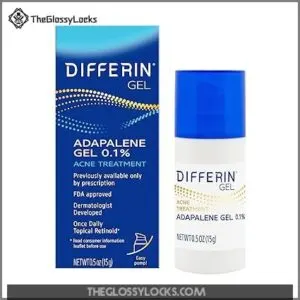
As the first FDA-approved over-the-counter retinoid, Differin Gel contains adapalene that works deep into your pores within minutes.
You’ll apply a pea-sized amount to damp skin, starting twice weekly and gradually increasing frequency.
While it’s fragrance-free and non-comedogenic, expect an initial "purge phase" where breakouts may worsen for several weeks.
Don’t let this discourage you—up to 87% reduction in acne occurs after 12 weeks of consistent use.
Always pair with sunscreen since retinoids increase sun sensitivity substantially.
Best For: Those with mild to moderate acne looking for a dermatologist-recommended, over-the-counter retinoid to prevent future breakouts.
- Initial purge phase may worsen acne for several weeks.
- Can cause dryness, redness, itching, or flaking without proper hydration.
- Requires consistent sunscreen use due to increased sun sensitivity.
- Reduces acne by up to 87% after 12 weeks of consistent use.
- Fragrance-free, oil-free, and non-comedogenic formula suitable for sensitive skin.
- Works deep into pores to improve skin tone and texture.
2. CeraVe Acne Foaming Cream Cleanser

In the case of gentle yet effective cleansing, CeraVe’s Acne Foaming Cream Cleanser delivers 4% benzoyl peroxide without the harshness.
You’ll love how this cream-to-foam formula removes excess oil while hyaluronic acid and ceramides keep your skin barrier intact.
It’s like having a bouncer at a club – tough on acne-causing bacteria but friendly to your sensitive skin.
The niacinamide helps calm inflammation, making it perfect for daily use.
Just remember to follow up with moisturizer since benzoyl peroxide can be drying.
Best For: People with acne-prone, sensitive, or oily skin looking for a dermatologist-developed cleanser that clears breakouts while maintaining skin hydration.
- Effective 4% benzoyl peroxide formula that clears acne and prevents new breakouts.
- Gentle cream-to-foam cleanser with hydrating ceramides and hyaluronic acid.
- Fragrance-free, paraben-free, and non-comedogenic formula suitable for daily use.
- Can dry out skin if not followed by a moisturizer.
- May leave bleach marks on towels and clothing.
- Less foamy than some users might expect.
3. PanOxyl 4% Benzoyl Peroxide Acne Wash
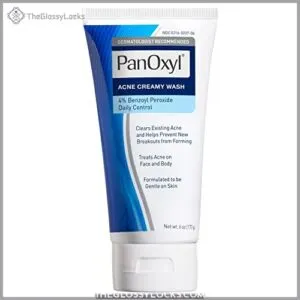
PanOxyl’s 4% Benzoyl Peroxide Acne Wash delivers dermatologist-recommended strength without overwhelming sensitive skin.
This gentle formula kills acne-causing bacteria on contact while lifting dirt from clogged pores.
You’ll find it works effectively on your face, chest, and back – making it perfect for treating stubborn body acne too.
The cream cleanser prevents new breakouts while clearing existing blemishes.
Since it’s formulated for daily use, you can incorporate it into your routine without worrying about excessive dryness or irritation.
Best For: People with mild to moderate acne looking for a gentle daily cleanser that prevents breakouts without causing excessive dryness.
- Effectively treats acne on face, chest, and back.
- Gentle enough for daily use, suitable for sensitive skin.
- Dermatologist-recommended and cost-effective compared to alternatives.
- May cause skin dryness or irritation with frequent use.
- Not suitable for use during pregnancy or breastfeeding without consulting a doctor.
- Can bleach towels or clothing due to Benzoyl Peroxide content.
4. Neutrogena Rapid Clear Acne Treatment
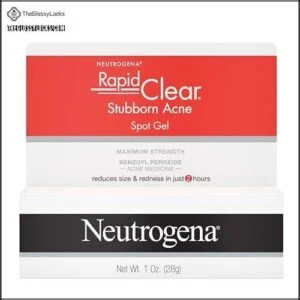
When stubborn breakouts refuse to budge, Neutrogena’s Rapid Clear Treatment delivers fast-acting relief.
This spot gel contains 10% benzoyl peroxide—the maximum strength available without a prescription. Clinical studies show it reduces acne size and redness within just two hours, making it perfect for those "emergency pimple" moments we all dread.
Apply it directly to problem areas once or twice daily, but start slowly since benzoyl peroxide can cause dryness. You’ll see noticeable improvement throughout the day as inflammation calms down, and with consistent use, achieve clearer skin.
Best For: Individuals with moderate to severe acne who need a fast-acting spot treatment for reducing breakouts and redness.
- Can cause skin dryness and flaking.
- May sting if used in high amounts or on sensitive skin.
- Can stain clothing if not handled carefully.
- Reduces acne size and redness within 2 hours.
- Maximum-strength benzoyl peroxide for effective results.
- Dermatologist-recommended for acne-prone skin.
5. Paulas Choice BHA Liquid Exfoliant

Paula’s Choice 2% BHA Liquid Exfoliant cuts through stubborn cystic acne with precision.
This powerhouse contains salicylic acid that dives deep into your pores, dissolving oil buildup and dead skin cells that fuel breakouts.
You’ll notice clearer skin within days as it prevents new cysts from forming.
The gentle, fragrance-free formula won’t irritate sensitive skin like harsh scrubs do.
Apply it after cleansing but before moisturizer – think of it as your skin’s daily reset button for smoother, brighter results, providing a daily reset.
Best For: Those with oily, acne-prone, or sensitive skin who want a gentle yet effective solution for unclogging pores and treating breakouts.
- Penetrates deep into pores to dissolve oil buildup and dead skin cells.
- Gentle, non-abrasive formula suitable for daily use.
- Improves skin texture, hydrates, and reduces fine lines and redness.
- May cause initial peeling or sensitivity for new users.
- Requires daily sunscreen due to increased sun sensitivity.
- High price point for the quantity provided.
6. La Roche Posay Face Moisturizer

When dealing with cystic acne and sensitive skin, you need a moisturizer that won’t aggravate existing breakouts.
La Roche-Posay’s Toleriane Double Repair Face Moisturizer delivers gentle hydration without clogging pores.
This oil-free formula contains ceramides and niacinamide to restore your skin’s protective barrier while reducing inflammation.
The lightweight texture absorbs quickly, making it perfect for layering under sunscreen or makeup.
It’s fragrance-free and non-comedogenic, so you can hydrate compromised skin without triggering new breakouts or irritation.
Best For: People with sensitive, acne-prone skin needing a gentle, hydrating moisturizer that restores the skin barrier without clogging pores.
- Lightweight, oil-free formula absorbs quickly and layers well under makeup or sunscreen.
- Contains ceramides and niacinamide to repair the skin barrier and reduce inflammation.
- Fragrance-free and non-comedogenic, ideal for sensitive or reactive skin.
- Some users may experience mild burning or greasiness initially.
- May not provide sufficient hydration for extremely dry skin.
- Distribution and availability may vary by region.
7. Neutrogena Oil-Free Salicylic Acid Cleanser
This gentle cleanser cuts through oil and debris without leaving your skin feeling tight as a drum.
Neutrogena’s Oil-Free Salicylic Acid Cleanser contains 2% salicylic acid that penetrates deep into pores to dissolve buildup before cysts can form.
The formula includes skin conditioners and soothing aloe extract to prevent over-drying—a common concern for sensitive skin types.
You’ll notice clearer pores and reduced blackheads within weeks, and just remember to follow up with sunscreen since salicylic acid increases sun sensitivity.
Best For: Adults and teens with acne-prone, oily skin looking for a gentle yet effective daily cleanser.
- Penetrates deep into pores to clear dirt, oil, and buildup.
- Contains soothing aloe extract to prevent over-drying.
- Leaves skin feeling clean without residue or tightness.
- May cause dryness or flakiness, requiring moisturizer.
- Increases sun sensitivity; sunscreen is necessary.
- Not ideal for very sensitive skin due to potential irritation.
8. La Roche-Posay Adapalene Acne Treatment
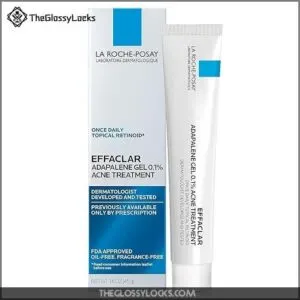
La Roche-Posay’s adapalene treatment brings prescription-strength power to your medicine cabinet without the doctor’s visit.
You’ll get 0.1% adapalene gel that regulates skin cell turnover, preventing dead cells from clogging your pores.
This dermatologist-developed formula targets blackheads, whiteheads, and those stubborn cystic bumps that seem to stick around forever.
Apply a pea-sized amount once daily in the evening after cleansing. Start slowly—maybe twice a week—then gradually increase frequency as your sensitive skin adjusts to this potent retinoid treatment.
This treatment helps regulate cell turnover, similar to benzoyl peroxide products.
Best For: Those with acne-prone skin looking to clear and prevent blackheads, whiteheads, and clogged pores using a dermatologist-developed retinoid treatment.
- Prescription-strength adapalene gel available without a prescription.
- Effective in clearing acne, reducing hyperpigmentation, and improving skin texture.
- Long-lasting product with gentle, unscented formulation when used correctly.
- May cause initial dryness, purging, or sensitivity during the adjustment period.
- Requires consistent use and patience as results take weeks to months.
- Not suitable for those without acne or frequent breakouts.
Sensitive Skin Care
When you’re dealing with cystic acne and sensitive skin, you can’t just throw powerful ingredients at the problem and hope for the best.
You’ll need to balance effective acne-fighting treatments with gentle formulas that won’t turn your face into an angry, irritated mess, using gentle approaches to achieve this balance.
Gentle Skincare Routine
When you’re managing cystic acne sensitive skin, building the right routine becomes your foundation.
Start with mild cleansers twice daily, followed by hydrating serums to maintain moisture balance. Gentle exfoliation once weekly helps prevent pore blockage without irritation.
Always finish with sun protection during the day. Using a suitable acne cleanser can substantially improve results.
Remember patch testing new sensitive skin products before full application – your skin will thank you for this cautious approach.
Avoiding Harsh Ingredients
When you have sensitive skin products that work for cystic acne treatment, ingredient sensitivity becomes your biggest concern. Your skin doesn’t need more irritation on top of existing inflammation.
Here’s what to avoid for nonirritating acne care:
- Skip potential irritants like strong fragrances
- Avoid formulas with harsh sulfates
- Stay away from abrasive scrubs
- Limit high-concentration salicylic acid
- Skip benzoyl peroxide if you’re reactive
To further avoid irritation, consider fragrance-free skincare options for sensitive skin.
Maintaining Hydration
Keeping your skin well-hydrated becomes your secret weapon against cystic acne sensitive flare-ups.
Use a moisturizer with hyaluronic acid to lock in moisture without clogging pores. Hydrating acne treatment products with glycerin work wonders for sensitive skin.
You can find a suitable hyaluronic acid product online.
Don’t forget internal hydration – drinking water supports your skin’s natural barrier while environmental factors like dry air can worsen irritation.
Preventing Cystic Acne
You can’t always stop cystic acne from happening, but you can reduce your chances by keeping your skin clean and avoiding habits that make breakouts worse.
Simple changes like not touching your face, eating a balanced diet, and managing stress can help prevent those painful, deep cysts from forming in the first place, which can lead to cystic acne.
Lifestyle Changes
Your daily habits can make or break your cystic acne sensitive skin journey.
Simple adjustments in how you live each day often deliver surprising results for acne treatment success.
Consider these lifestyle tweaks for clearer, healthier skin:
- Exercise habits: Regular movement boosts circulation and reduces stress, but always cleanse afterward to remove sweat and bacteria
- Sleep quality: Aim for 7-9 hours nightly to support skin healing and hormone regulation
- Hydration levels: Drink plenty of water throughout the day to maintain skin moisture and flush out toxins
To further minimize breakouts, consider gentle cleansing practices.
Dietary Considerations
Your diet plays a bigger role in cystic acne than you’d think.
Cut back on sugar intake and dairy effects since they trigger inflammation. Focus on gut health with whole foods, fruits, and vegetables for inflammation reduction.
Don’t forget hydration importance – water helps flush toxins that worsen sensitive skin. Your acne treatment starts on your plate.
Stress Management
Chronic stress triggers hormonal spikes that worsen cystic acne on sensitive skin.
When cortisol levels soar, your body produces more oil, creating the perfect storm for breakouts.
The mind-body connection runs deep—what affects your emotional wellbeing directly impacts your complexion.
Practice relaxation techniques like meditation or yoga to break this cycle and support your acne treatment routine.
Regular Skincare Maintenance
Beyond managing stress, your sensitive skin needs consistent care to prevent cystic acne flare-ups.
A solid skincare routine acts like a protective shield against breakouts.
Here’s your daily maintenance checklist:
- Gentle Cleansing twice daily with non-comedogenic, fragrance-free cleansers
- Daily Hydration using oil-free moisturizers to maintain skin barrier function
- Sun Protection with broad-spectrum SPF 30+ to prevent inflammation
- Exfoliation Frequency limited to 2-3 times weekly with mild chemical exfoliants
- Product Application in thin layers, allowing absorption between steps
Using the right products can help, so be sure to choose appropriate moisturizers.
Frequently Asked Questions (FAQs)
What is the fastest way to get rid of a cystic pimple?
Schedule a cortisone injection with your dermatologist—it’s the fastest professional solution, reducing inflammation within 24-48 hours.
Meanwhile, apply ice wrapped in cloth for 10-15 minutes to minimize swelling and pain.
What do dermatologists recommend for acne on sensitive skin?
Like old-timey apothecaries, dermatologists recommend you start with gentle, fragrance-free cleansers containing low-concentration salicylic acid or benzoyl peroxide. They’ll suggest non-comedogenic moisturizers and gradual introduction of retinoids to avoid irritation.
Is cystic acne hormonal or bacterial?
Cystic acne is both hormonal and bacterial.
Your hormones trigger excess oil production, creating the perfect breeding ground for bacteria like P. acnes.
This combo creates those painful, deep cysts that won’t budge easily.
What not to put on cystic acne?
Playing with fire means avoiding harsh scrubs, alcohol-based toners, and picking at cysts.
Don’t use comedogenic oils, over-the-counter spot treatments with high concentrations, or multiple active ingredients simultaneously—you’ll inflame your skin further with harsh actions.
How long does cystic acne take to heal?
Individual cysts typically take 2-6 weeks to heal completely, but you’ll notice improvement within 24-48 hours with proper treatment.
Deep, inflamed cysts need patience—rushing the process often leads to scarring.
Can makeup worsen cystic acne on sensitive skin?
Yes, makeup can worsen cystic acne on sensitive skin.
Heavy, comedogenic formulas clog pores and trap bacteria.
You’ll want to choose non-comedogenic, oil-free products and always remove makeup thoroughly before bed.
When should I see a dermatologist for treatment?
Timing matters when your skin rebels.
See a dermatologist immediately if you’ve tried over-the-counter treatments for six weeks without improvement.
Or if painful cysts appear frequently, causing scarring or affecting your confidence.
Are natural remedies safe for sensitive cystic acne?
Natural remedies can be gentle but aren’t always effective for severe cystic acne.
Tea tree oil and turmeric show promise, but patch-test first.
They work best alongside proven treatments rather than replacing professional care.
What skincare ingredients should sensitive skin avoid completely?
Like traversing a minefield, you’ll want to steer clear of alcohol-based toners, harsh scrubs, sulfates, and high-concentration acids.
These irritants can turn your sensitive skin into a battlefield of inflammation and worsen existing breakouts.
Conclusion
Mastering cystic acne treatment for sensitive skin is like learning to dance with your complexion rather than fighting against it.
You’ve got the roadmap now—gentle retinoids, low-concentration benzoyl peroxide, and protective moisturizers.
Remember, consistency trumps intensity every time.
Your skin didn’t develop cystic acne overnight, so healing won’t happen instantly either.
Stick with these proven products, listen to your skin’s signals, and you’ll transform your routine from a daily battle into a sustainable victory.
- https://www.nhs.uk/conditions/acne/treatment
- https://my.clevelandclinic.org/health/diseases/21737-cystic-acne
- https://www.mayoclinic.org/diseases-conditions/acne/in-depth/acne-treatments/art-20045814
- https://www.paulaschoice-eu.com/cystic-acne-treatment-plan
- https://www.allure.com/story/how-to-treat-cystic-acne

